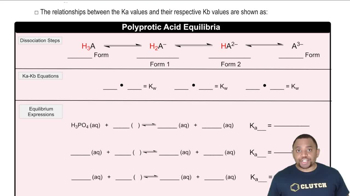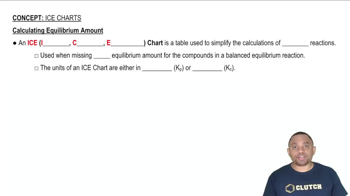For the reaction shown here, Kc = 255 at 1000 K. CO(g) + Cl2(g) ⇌ COCl2(g) If a reaction mixture initially contains a CO concentration of 0.1500 M and a Cl2 concentration of 0.175 M at 1000 K, what are the equilibrium concentrations of CO, Cl2, and COCl2 at 1000 K?
Ch.15 - Chemical Equilibrium

Chapter 15, Problem 57
Consider the reaction: HC2H3O2(aq) + H2O(l) ⇌ H3O+(aq) + C2H3O2-(aq) Kc = 1.8⨉10-5 at 25°C If a solution initially contains 0.210 M HC2H3O2, what is the equilibrium concentration of H3O+ at 25 °C?
 Verified step by step guidance
Verified step by step guidance1
Write the expression for the equilibrium constant (Kc) for the reaction: \( K_c = \frac{[H_3O^+][C_2H_3O_2^-]}{[HC_2H_3O_2]} \).
Set up an ICE table (Initial, Change, Equilibrium) to track the concentrations of reactants and products. Initially, [HC_2H_3O_2] = 0.210 M, and [H3O+] and [C2H3O2-] are 0 M.
Let 'x' be the change in concentration of H3O+ and C2H3O2- formed at equilibrium. Therefore, the change in concentration of HC2H3O2 is -x.
At equilibrium, the concentrations will be [HC2H3O2] = 0.210 - x, [H3O+] = x, and [C2H3O2-] = x.
Substitute the equilibrium concentrations into the Kc expression and solve for x, which represents the equilibrium concentration of H3O+.

Verified video answer for a similar problem:
This video solution was recommended by our tutors as helpful for the problem above.
Was this helpful?
Key Concepts
Here are the essential concepts you must grasp in order to answer the question correctly.
Equilibrium Constant (Kc)
The equilibrium constant, Kc, quantifies the ratio of the concentrations of products to reactants at equilibrium for a reversible reaction. It is calculated using the formula Kc = [products]/[reactants], where the concentrations are raised to the power of their coefficients in the balanced equation. A small Kc value, like 1.8 x 10^-5, indicates that at equilibrium, the reaction favors the reactants over the products.
Recommended video:
Guided course

Equilibrium Constant Expressions
Acid-Base Equilibrium
In the context of the given reaction, HC2H3O2 (acetic acid) acts as a weak acid that partially dissociates in water to form H3O+ (hydronium ion) and C2H3O2- (acetate ion). Understanding the concept of weak acids is crucial, as they do not completely ionize in solution, leading to an equilibrium state where both the undissociated acid and its ions coexist.
Recommended video:
Guided course

Triprotic Acid Equilibrium
ICE Table (Initial, Change, Equilibrium)
An ICE table is a tool used to organize the initial concentrations, the changes in concentrations as the reaction proceeds, and the equilibrium concentrations of the species involved in a chemical reaction. By setting up an ICE table for this reaction, one can systematically determine the equilibrium concentrations of H3O+ and other species, facilitating the calculation of the desired equilibrium concentration.
Recommended video:
Guided course

ICE Charts and Equilibrium Amount
Related Practice
Textbook Question
2
views
Textbook Question
Consider the reaction: SO2Cl2(g) ⇌ SO2(g) + Cl2(g) Kc = 2.99⨉10-7 at 227 °C If a reaction mixture initially contains 0.175 M SO2Cl2, what is the equilibrium concentration of Cl2 at 227 °C?
1
views
Textbook Question
Consider the reaction: A(g) ⇌ B(g) + C(g) Find the equilibrium concentrations of A, B, and C for each value of Kc. Assume that the initial concentration of A in each case is 1.0 M and that the reaction mixture initially contains no products. Make any appropriate simplifying assumptions. b. Kc = 0.010
1
views
